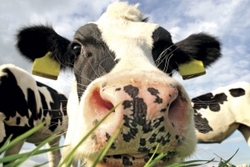Financial News | 21 January 2013
by Sarah Krouse
When Graham Birch, a former portfolio manager at BlackRock, considered swapping funds for farming five years ago, his search for land spanned the globe as he looked for reasonably priced pastures.
Birch decided he wanted to manage his own farm but it became clear early on that he needed to learn more about climate, location, scale and price.
He said: “What I realised quite quickly is that it’s tempting to say, ‘let’s go find where the cheapest land is because you get more bang for your buck,’ but what you quickly discover is that land in some parts of the world is cheap for a reason.”
For example, some markets have less mature legal frameworks or infrastructure for transporting goods to market.
The former fund manager’s search for land highlights the decisions investors face as they consider the growing trend of investing in farmland.
In a July letter to investors, Jeremy Grantham, founder and chief strategist of fund manager GMO, recommended that long-term investors dedicate at least 30% of their portfolios to resources, with roughly half of that in forestry and farmland.
Several factors are contributing to what he characterises as a global food crisis – diminishing output from the use of fertiliser, a growing population and global warming. Grantham said: “I am very bearish on the problems we humans face and, sadly, very bullish on resources.”
Prospective investors in farmland have to decide how hands-on they want to be and how much risk they are willing to assume.
For institutionals, these questions are similar to factors they consider when investing in other illiquid assets such as infrastructure and property.
The price of farmland is driven by global fundamentals, not least a growing world population that is driving up demand for food.
Last year, droughts in the US ruined maize crops while unexpected rains hit Brazil, prompting fears of a food crisis. The maize market has since shown signs of improvement thanks, in part, to large exports of maize from South America.
As institutions and private investors show increased interest in farmland, prices are rising. Last year, a report on international farmland by property consultancy Savills said prices had jumped the most in immature markets such as Hungary, Romania, Brazil and Argentina between 2002 and 2010 as investors moved in.
Some governments responded by imposing restrictions on foreign investments to curb growth.
In the UK, property agent Knight Frank expects farmland prices to rise 5% this year, after climbing 3% to an average of £6,214 per acre in 2012.
Fund manager-turned-farmer Birch said economies of scale meant buyers of agricultural land might have to play a waiting game.
He purchased a farm in Dorset, where he now controls 2,300 acres across two farms, producing three million litres of milk per year as part of a contract with Marks & Spencer. He has 10 employees and also produces wheat, barley and rapeseed.
He said: “On the whole, people don’t trade farmland very much unless they absolutely have to. The three Ds – death, divorce and debt – those are three things that make people sell their land. It’s a matter of patience and you have to be prepared to be opportunistic.”
There are several ways to invest in farmland, including putting money into a fund that invests in agriculture; buying greenfield developments; purchasing farms to let out; seeking semi-developed farmland; or opting for arable land to farm or co-manage.
But farmland investing is wrought with pitfalls, ranging from natural disasters, to pests, disease and rising capital costs.
Institutional investors’ choice of agricultural investment depends on the percentage of their portfolio they are willing to invest, their internal expertise and their risk appetite.
They often buy land either to let to a tenant farmer or enter into a contract farming agreement, sharing both operational costs and the upside in a joint venture.
A survey last year by Savills estimated that of the $32 trillion in assets managed by pension funds worldwide, about $15bn was invested in farmland.
Pension funds
US teacher’s pension fund TIAA-CREF has invested more than $2bn in agriculture since 2007. It invests directly in farmland in several countries including Australia, Europe, the US and in South America. It also considers crop types and operating strategies in diversifying its holdings.
In the UK, the £1.9bn Environment Agency pension fund and the Pension Protection Fund said last year that they planned to invest in farmland. Other European pension fund farmland investors include Sweden’s AP2 pension fund, which invested alongside TIAA-CREF, German fund Ärzteversorgung Westfalen-Lippe, and Danish scheme PKA.
High net worth investors on the other hand, particularly in the UK, tend to put money into farmland as a safe haven – they want arable land that is not split into parcels that they will hold for generations, said James Prewett, head of regional farm sales at Knight Frank.
That type of investment typically yields 1.5% to 2%.
Prewett said: “I think what has happened is that as other assets have performed badly or looked risky, [investors have] said, ‘right, where can we put money for the long term?’ It’s a physical asset, there are tax advantages and it gets back to the old adage that they’re not making any more of it.”
On the higher end of the risk and return spectrum, Genagro, the firm founded by Jim Slater and Ian Watson that invests in Brazilian farmland, targets returns of 15% to 20% over three to five years. It uses a more capital and resource-intensive process of developing farms on open land.
Jonathan Davis, investment director of Genagro, said: “For us, the primary return comes from the increase in capital value from transforming land that produces nothing into one that offers a sustainable farming yield.”
by Sarah Krouse
When Graham Birch, a former portfolio manager at BlackRock, considered swapping funds for farming five years ago, his search for land spanned the globe as he looked for reasonably priced pastures.
Birch decided he wanted to manage his own farm but it became clear early on that he needed to learn more about climate, location, scale and price.
He said: “What I realised quite quickly is that it’s tempting to say, ‘let’s go find where the cheapest land is because you get more bang for your buck,’ but what you quickly discover is that land in some parts of the world is cheap for a reason.”
For example, some markets have less mature legal frameworks or infrastructure for transporting goods to market.
The former fund manager’s search for land highlights the decisions investors face as they consider the growing trend of investing in farmland.
In a July letter to investors, Jeremy Grantham, founder and chief strategist of fund manager GMO, recommended that long-term investors dedicate at least 30% of their portfolios to resources, with roughly half of that in forestry and farmland.
Several factors are contributing to what he characterises as a global food crisis – diminishing output from the use of fertiliser, a growing population and global warming. Grantham said: “I am very bearish on the problems we humans face and, sadly, very bullish on resources.”
Prospective investors in farmland have to decide how hands-on they want to be and how much risk they are willing to assume.
For institutionals, these questions are similar to factors they consider when investing in other illiquid assets such as infrastructure and property.
The price of farmland is driven by global fundamentals, not least a growing world population that is driving up demand for food.
Last year, droughts in the US ruined maize crops while unexpected rains hit Brazil, prompting fears of a food crisis. The maize market has since shown signs of improvement thanks, in part, to large exports of maize from South America.
As institutions and private investors show increased interest in farmland, prices are rising. Last year, a report on international farmland by property consultancy Savills said prices had jumped the most in immature markets such as Hungary, Romania, Brazil and Argentina between 2002 and 2010 as investors moved in.
Some governments responded by imposing restrictions on foreign investments to curb growth.
In the UK, property agent Knight Frank expects farmland prices to rise 5% this year, after climbing 3% to an average of £6,214 per acre in 2012.
Fund manager-turned-farmer Birch said economies of scale meant buyers of agricultural land might have to play a waiting game.
He purchased a farm in Dorset, where he now controls 2,300 acres across two farms, producing three million litres of milk per year as part of a contract with Marks & Spencer. He has 10 employees and also produces wheat, barley and rapeseed.
He said: “On the whole, people don’t trade farmland very much unless they absolutely have to. The three Ds – death, divorce and debt – those are three things that make people sell their land. It’s a matter of patience and you have to be prepared to be opportunistic.”
There are several ways to invest in farmland, including putting money into a fund that invests in agriculture; buying greenfield developments; purchasing farms to let out; seeking semi-developed farmland; or opting for arable land to farm or co-manage.
But farmland investing is wrought with pitfalls, ranging from natural disasters, to pests, disease and rising capital costs.
Institutional investors’ choice of agricultural investment depends on the percentage of their portfolio they are willing to invest, their internal expertise and their risk appetite.
They often buy land either to let to a tenant farmer or enter into a contract farming agreement, sharing both operational costs and the upside in a joint venture.
A survey last year by Savills estimated that of the $32 trillion in assets managed by pension funds worldwide, about $15bn was invested in farmland.
Pension funds
US teacher’s pension fund TIAA-CREF has invested more than $2bn in agriculture since 2007. It invests directly in farmland in several countries including Australia, Europe, the US and in South America. It also considers crop types and operating strategies in diversifying its holdings.
In the UK, the £1.9bn Environment Agency pension fund and the Pension Protection Fund said last year that they planned to invest in farmland. Other European pension fund farmland investors include Sweden’s AP2 pension fund, which invested alongside TIAA-CREF, German fund Ärzteversorgung Westfalen-Lippe, and Danish scheme PKA.
High net worth investors on the other hand, particularly in the UK, tend to put money into farmland as a safe haven – they want arable land that is not split into parcels that they will hold for generations, said James Prewett, head of regional farm sales at Knight Frank.
That type of investment typically yields 1.5% to 2%.
Prewett said: “I think what has happened is that as other assets have performed badly or looked risky, [investors have] said, ‘right, where can we put money for the long term?’ It’s a physical asset, there are tax advantages and it gets back to the old adage that they’re not making any more of it.”
On the higher end of the risk and return spectrum, Genagro, the firm founded by Jim Slater and Ian Watson that invests in Brazilian farmland, targets returns of 15% to 20% over three to five years. It uses a more capital and resource-intensive process of developing farms on open land.
Jonathan Davis, investment director of Genagro, said: “For us, the primary return comes from the increase in capital value from transforming land that produces nothing into one that offers a sustainable farming yield.”














